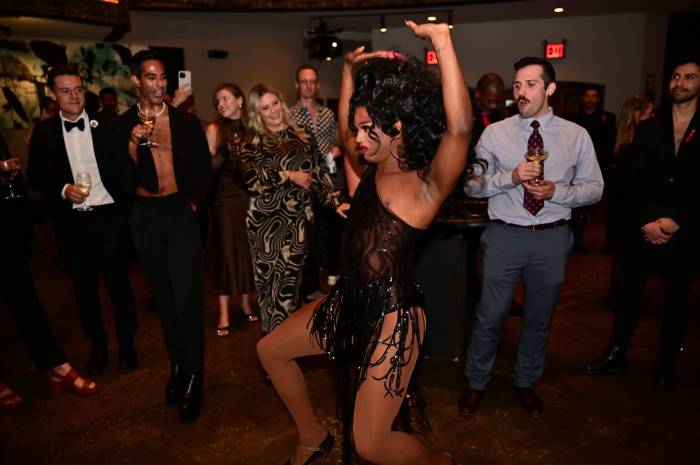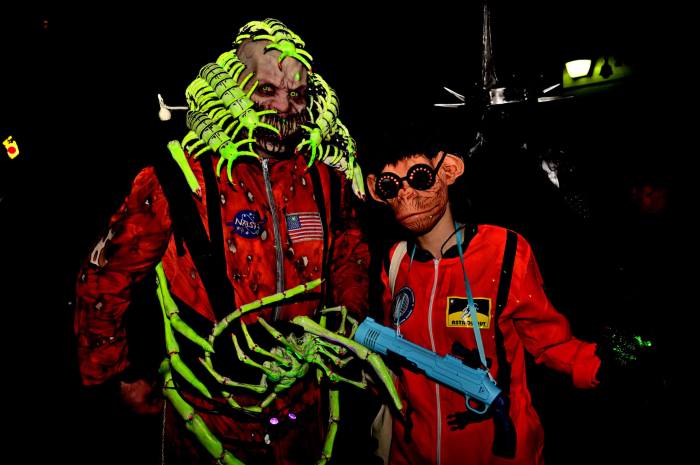Colman Domingo, perhaps the busiest actor around today, is directing Carlo D’Amore’s “No Parole” and is set to star in “Wild With Happy” at the Public Theater in October. | COLMANDOMINGO.COM
I frankly don’t think there’s a busier guy in show business right now than Colman Domingo. He’s directing the one-man show “No Parole,” written and performed by Carlo D’Amore for the All For One Theater Festival. It’s the real life account of a gay man who acts as accomplice to his con artist mother, who adopts a myriad of poses — professor, daycare worker, immigration attorney. (Sep. 16, 7 p.m.; Sep. 29, 4:30 p.m.; Cherry Lane Theatre, 28 Commerce St., btwn. Bedford & Barrow Sts.; afofest.org.)
In the fall, the Public Theater will be host to Domingo’s new play, “Wild with Happy,” in which he stars as Gil, a gay man bent on scattering his dead mother’s ashes in the place she was most happy, Disneyland. Robert O’Hara directs a cast that also includes Korey Jackson, Maurice McRae, and Sharon Washington. (Oct. 9-Nov. 11; 425 Lafayette St., btwn. E. Fourth St. & Astor Pl.; publictheater.org.)
As if that weren’t enough, Domingo has more movies coming out than Samuel L. Jackson, which is really saying something. He spoke to me from the New Orleans set of “The Butler” — Lee Daniels’ latest project — which is the true story of Eugene Allen (Forest Whitaker), the White House servant who served eight American presidents, lived through the civil rights movement, and was brought out of retirement to witness Obama’s inauguration.
“I play one of the other butlers, and Oprah Winfrey’s also in this,” Domingo said. “I haven’t met her yet but I had a sighting of her yesterday, going into the makeup trailer! Lee Daniels is amazing and I feel blessed to be working with him.”
Domingo then rattled off the amazing list of his other movies for me.
The recently released “Red Hook Summer”: “This was my third time working with Spike Lee, and I think the third time is the charm. Although he does make mistakes, he’s really a good guy and we are kindred spirits. We were shooting in Brooklyn for 19 days last summer. In it, I play a key character named Blessing Rowe, who comes in late and I can’t really describe, because he’s the plot spoiler.”
“Lincoln”: “I finished shooting that with Spielberg, from a script by Tony Kushner. I play a soldier, Private Harold Green, who has some wonderful moments with the president [Daniel Day Lewis]. Working with Spielberg was just a beautiful experience, and he’s so humble and generous, as was Daniel Day Lewis.”
“Lucky Dog”: “That’s with Paul Rudd, Paul Giamatti, and Sally Hawkins. In it, I have my very first screen kiss — with Paul Rudd! It’s funny, hysterical, like one of the ‘Weekend with Bernie’ films, very silly.”
“’42”: “It’s the life story of Jackie Robinson, played by Chadwick Boseman, shot in Georgia, and I play a New York restaurateur, Lawson Bowman, who owned a Harlem steakhouse where he and Robinson had a great relationship.
“There’s also ‘Hair Brain’ with Parker Posey and Brendan Fraser, and something called ‘Newlyweeds,’ with ‘Langston’ also coming up. That makes about nine films coming out through next year, which is very exciting.”
Domingo was nominated for a Tony for “The Scottsboro Boys,” which, with its minstrel show theme, caused quite a stir.
“My first reaction to the material was ‘Wow! I’ve never read anything like this or seen anything like this, and I would absolutely love to be a part of this!,’” he recalled. “Just for the calibre of people I was working with alone — Kander & Ebb, Susan Stroman. I never had so much fun being so evil as that character. Had the time of my life!”
The show was picketed by African Americans who found it distasteful, but Domingo said, “It was heavy, but I’m very outspoken and thought nothing of going up to them and speaking. Actually, there was just a handful of protesters, maybe 16 tops, maybe twice. It was no Million Man March like the press would have you believe. But I would go up to the front of the line and ask if they had seen the show. They said, ‘No,’ and I would invite them to see it, and said, ‘I would love to buy you a ticket and then set up a talkback afterwards you can participate in.’ But they didn’t want to, because they would rather detach themselves from it. I do think there were some problems with the marketing, because we were represented as a minstrel show as opposed to when we were at the Guthrie Theater [in Minneapolis], where the words ‘minstrel show’ were never mentioned.
“I did speak to the Amsterdam News, a paper I will never read again for the way they treated us. This writer called me up and didn’t do her research. She asked, ‘So you’re white, right? And the whole cast is white, right?’ So, in her mind, we were a group of white actors doing a minstrel show. That’s what we had to deal with.”
I expressed my admiration for Domingo’s always being out and proud, especially growing up at a time when acceptance of gays was far rarer than it is today, and he said, “It’s funny, because I went to speak at the University of Wisconsin six months ago, and this old black queen stood up and said, ‘I want you to acknowledge what you are and what you’re doing and how it hasn’t really ever been done on the level that you’re doing it!’
“For me, I’ve just been working my way along my journey. I’ve never had to come out. I’ve always been out. It’s never been an issue, from the time of my doing Athol Fugard’s ‘Blood Knot,’ in which I played this hot-blooded guy always talking about sex with women. Whatever my sexuality may be, possibly I am able to transcend all that.”
The Museum of Modern Art will have a very special guest on September 5, when Diana Serra Cary will introduce Vera Iwerebor’s documentary about her life, “Baby Peggy: The Elephant in the Room” (6:30 p.m.; 11 W. 53rd St.; moma.org). As the beyond-adorable Baby Peggy, Cary, born in 1918, was the Shirley Temple of her day, after Jackie Coogan, the biggest child star of the silent era, pulling in $1.5 million a year. She was the first child star to be a corporation and mass-marketed, with lines of Baby Peggy dolls, clothing, and sheet music, and she was the mascot of the 1924 Democratic Convention in New York, photographed alongside Franklin Roosevelt.
She made her debut at 18 months, but by the age of nine was washed up — after her father fought over her salary, leading to the cancellation of her contract and her being blacklisted in the industry. Her father continued to blight her life, financially, even blowing the money she earned by performing live in vaudeville after her film career ended. Returning to Hollywood as a young adult, she could only find work as an extra.
Today, Cary is almost as adorable, a tirelessly upbeat survivor and grandmother, who overcame her dysfunctional family to find a happy married life and motherhood. She also overcame her lack of any formal education — she was always too busy working under scandalously unmonitored childhood conditions — to author two important books of film history. She makes personal appearances for worshipful movie fans and researches her own past and career now, having come to terms with her ambivalence toward it. Only 12 of the 56 short films she made in her heyday survive, most of them discovered in Europe, and this wonderfully warm and affectionate documentary shows her being fêted at a theater that was hosting an all-day retrospective of her work.
For Cary, insanity was, for a long time, her normal state; she herself wryly confesses, “I used to look at my little boy playing with such anger. Why isn’t he working, like I was at his age? And then I realized what I was saying!”
Steve Martin in Carl Reiner’s 1983 “The Man With Two Brains,” screeing at BAM on September 7 at 4:30 and 9:15 p.m. | BAMCINÉMATEK/ PHOTOFEST
Brooklyn Academy of Music’s film series, “American Gagsters: Great Comedy Teams” has already begun (through Sep. 17; 30 Lafayette Ave. at Ashland Pl.; bam.org), but you can still catch a slew of films with memorably hilarious moments. There’s Kim Novak at her most charismatically somnambulistic, decked out in spiffy red and black Jean Louis ensembles, as a witch in a snowy Greenwich Village fantasy world, creating havoc for snotty rival Janice Rule in “Bell, Book and Candle”; Gene Wilder brilliantly having conniptions over his security blanket in “The Producers”; the song “Under the Bamboo Tree” and how it’s used in “The Man with Two Brains”; Diane Keaton and Woody Allen doing “A Streetcar Named Desire” in the middle of “Sleeper.” And then there are my absolute two favorites — the Ethel Merman sequence in “Airplane!” and every fucking thing Cloris Leachman does as Frau Blücher in “Young Frankenstein” (whinny!).
Contact David Noh at Inthenoh@aol.com and check out his blog at http://nohway.wordpress.com/.




































